 Do you sell goods and services online internationally? If so, then here’s a great idea: think about providing your prospects with the convenience of currency conversion on your e-commerce web site.
Do you sell goods and services online internationally? If so, then here’s a great idea: think about providing your prospects with the convenience of currency conversion on your e-commerce web site.
Currency conversion tools allow your visitors to translate international currency amounts into their local currency when checking out products online. It also lets visitors and customers see the exact amount their card or PayPal account will be charged, displayed in their local currency.
The obvious advantage of adding currency conversion is that it allows visitors to view and understand prices in foreign countries in their own home currency, and makes it easier for visitors to calculate their costs and expenses.
Fortunately, if you are a WordPress user, it’s really easy and simple to add currency conversion using a plugin to currency conversion to your WordPress website via a plugin, allowing your site visitors to quickly understand the cost of your goods.
Currencyr – WordPress Free Currency Converter
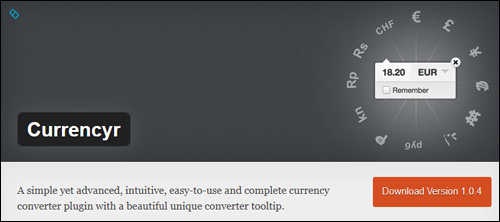
Currencyr is a simple, easy-to-use and complete currency converter plugin with a unique converter tooltip. And, it’s also free to install and use on your website or blog.
This currency conversion WP plugin features:
- In-line converter
- Supports a number of exchange rates providers, such as Yahoo! and European Central Bank
- Support database cache driven for fast response
- Currency table and converter widget
- Can be integrated with a number of e-commerce plugins like WooCommerce, WP-eCommerce, Shopp, and Easy Digital Downloads.
- Automatic local currency detection
- Translation support
Note: The Currencyr plugin needs your server to be running PHP 5.3.0 or later. Do not install this plugin if you currently have an older version of PHP installed on your server. Alternatively, ask your web host to check and upgrade your PHP server installation.
***
You can install the Currencyr plugin from your WordPress dashboard by typing in “currencyr” into the Plugins search field and clicking “Install Now” …
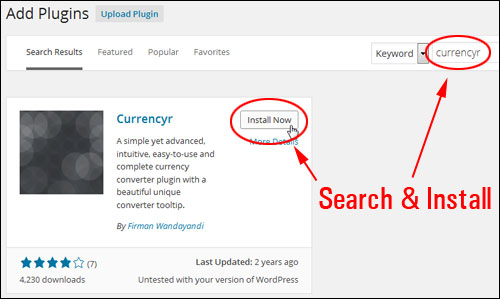
After you have installed and activated the plugin, you can get to the plugin’s settings page by choosing Currencyr from your admin menu …

The plugin settings screen provides several configuration settings …
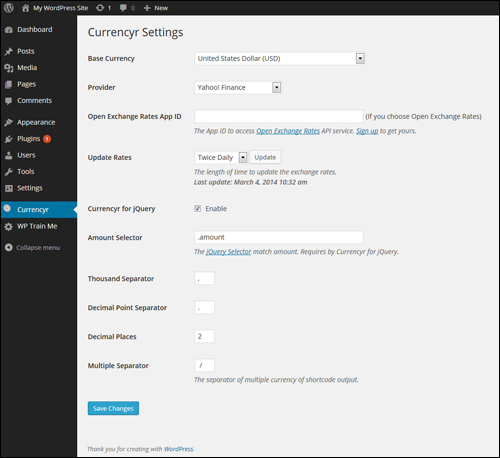
For example, you can select your base currency from a dropdown menu if you prefer to use something other than the default option ‘United States Dollar – (USD)’ …
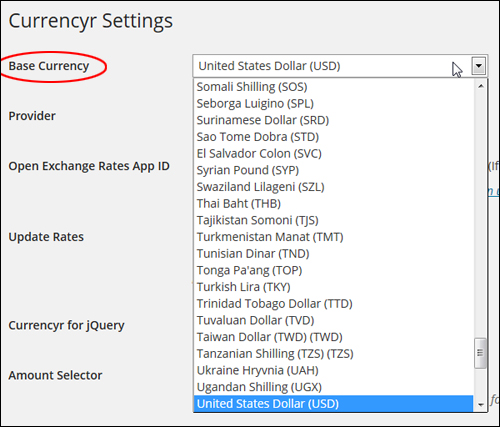
Similarly, you can select a data provider from a drop-down menu. The default provider is Yahoo Finance, but you can select one of the other options, like European Central Bank, FoxRate, Google Finance or Open Exchange Rates …

Note: If you select Open Exchange Rates as your provider, an API (Application Programming Interface) will be required …

You can choose how frequently you want to update the exchange rates by specifying an option from the ‘Update Rates’ dropdown menu …

The plugin uses jQuery, which lets web developers add things like animation effects to web applications (e.g. WP plugins).
If you have no reason to edit the jQuery settings, you can just ignore this setting …

Configure the rest of the plugin settings to suit your preferences and remember to click Save Changes when done …
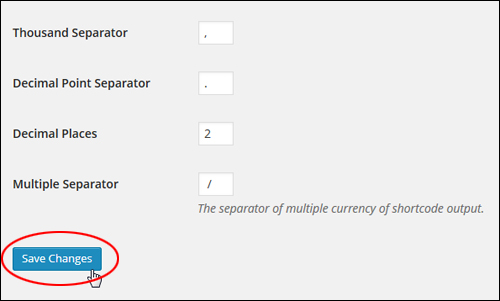
When your plugin settings have been configured, you can easily add currency conversion to any of your WordPress blog’s posts or pages using widgets.
Refer to the ‘Additional Plugin Notes’ section at the bottom of this tutorial to learn how to use currency codes (e.g. USD, GBP, ZAR, etc …) with this plugin.
Using Currencyr Shortcodes
You can add currency conversion to WP posts, pages and widgets with no web coding knowledge or skills using shortcodes.
Let’s take a look at some examples of currency shortcodes that you can add to WP posts and pages:
Let’s say that you are selling an item online for a fixed amount (e.g. $175) in US Dollars (USD), and you would also like to show this amount converted into British pounds (GBP) on your product sales page.
All you need to do is insert the shortcode below to your page content …

Note: You can also display prices in dollars and cents (for example, 155.25, 22.00, 295.75, etc …)
The screenshot below shows how your shortcode looks once you have inserted it into your page …
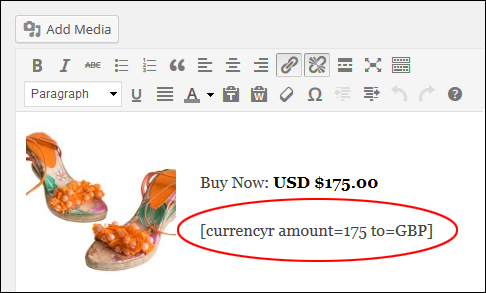
After publishing your content, the currency conversion will display as shown below …
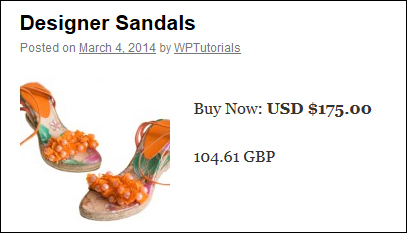
Using the same example, let’s also display the same amount into multiple currencies.
To do this, use following shortcode (you can add as many currency symbols as you want separated by vertical pipes) …

The example below now shows how the above shortcode appears when added to a page …

Once the post or page has been published, the converted currency amounts will then appear as you can see in the example below …
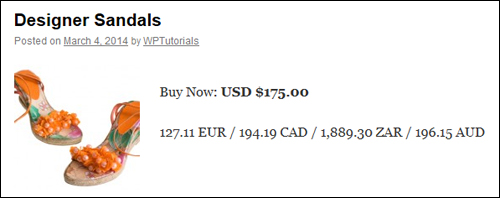
See the ‘Additional Plugin Notes’ section further below to learn how to change the currency separator symbol within this plugin.
Now, suppose you want to specify a different base currency than the one you have selected as your default.
For example, say you have set your default base currency as EUR and you have a section on your site targeted to non-European customers (like Australia or Canada), you can change the base currency using the following shortcode …

The screenshot below shows how the above shortcode appears when you add it to a post …
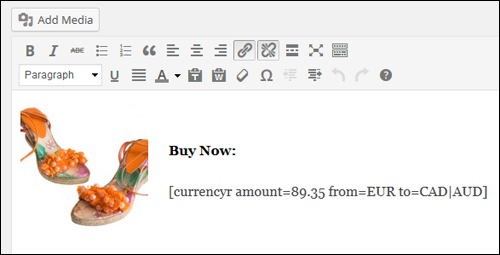
Once the page or post has been published, your converted currency amounts will then display like this …

How To Use The Plugin Widget
You can also add currency conversion to your website or blog’s sidebar using the plugin’s widget.
To add the currency converter to your sidebar area, select Appearance > Widgets from the WordPress user admin menu …
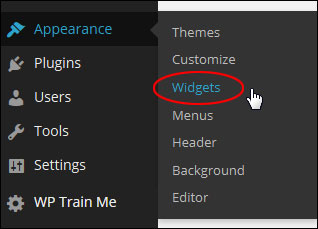
In the Widgets > Available Widgets section find the ‘Currencyr’ widget and add it to an ‘Active Widgets’ location …
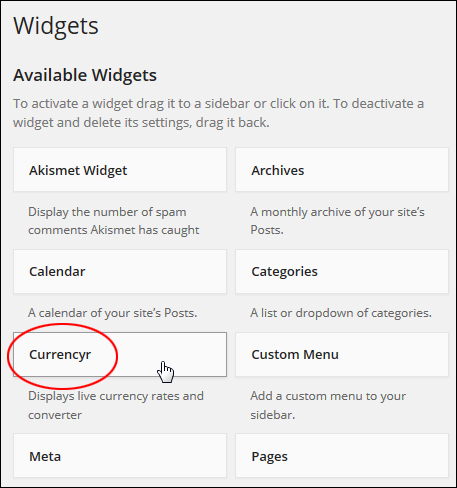
Configure the widget settings as shown in the example below (add the currency codes you would like to display on your widget separated by commas), and click Save to save your settings …
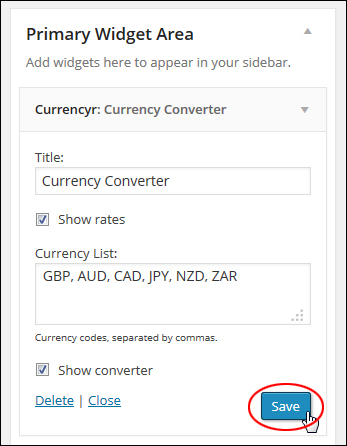
The currency conversion tool will now appear on the sidebar menu with the settings you have specified …
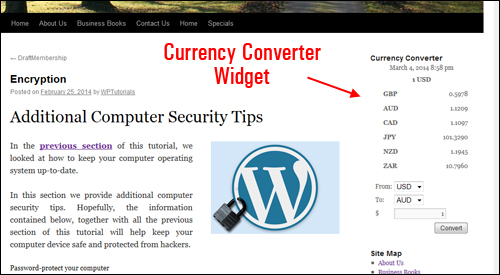
Additional Plugin Notes
This section contains additional information about using the plugin.
Currency Separator
The Currencyr plugin allows you to specify a symbol of your choice to display as the currency separator when using multiple currencies.
You can change the symbol in the Multiple Separator settings section.
So, for example, entering the default symbol “/” (forward slash) …

Displays your currency values separated by a forward slash as you can see in the example below …
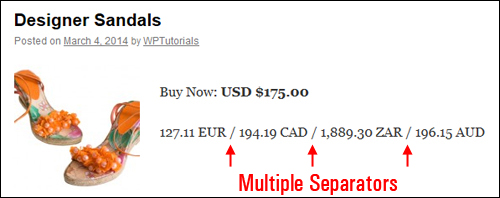
If you select another symbol and resave your settings …

Your website visitors will see the new symbol used as the currency separator …
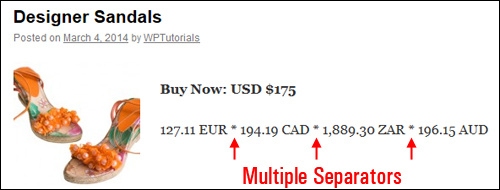
WP E-Commerce
As described earlier, the plugin integrates with a number of WP-compatible e-commerce plugins such as WooCommerce, WP-eCommerce, Shopp, and Easy Digital Downloads …
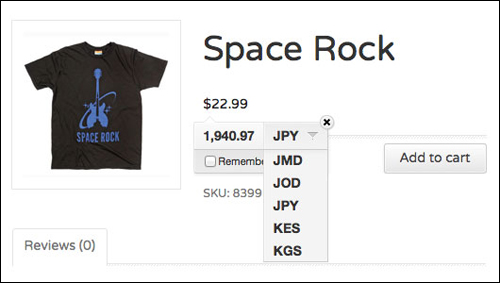
(image source: Currencyr plugin site)
Congratulations! Now you know how to easily add currency conversion to your e-commerce site.
To learn more about WordPress e-commerce plugins, see the tutorial below:
***
"Wow! I never knew there's so much to learn about WordPress! I bought one of the WordPress for Dummies three years ago, such authors need to be on this course!" - Rich Law, Create A Blog Now